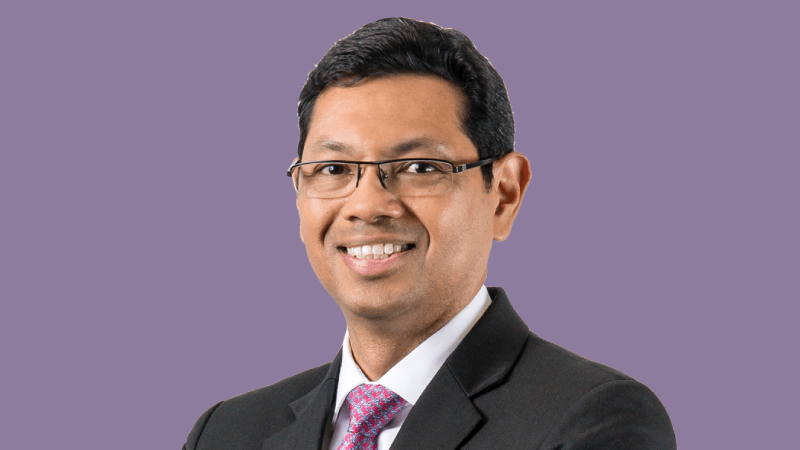WHY PAUL SANDOSHAM WANTS TO HELP REDUCE CONSTRUCTION DISPUTES
Plus, how he continues to find meaning in practice, 25 years on.

BY ASHUTOSH RAVIKRISHNAN
A disputes lawyer trying to reduce disputes might seem counterintuitive. But that’s precisely what Mr Paul Sandosham hopes to do with fellow members of the Building and Construction Subcommittee of SAL’s Law Reform Committee. Together, they have penned a guide to collaborative contracting in the construction industry, in hopes of educating the profession and other stakeholders about an alternative model of contracting for construction projects. “Collaborative contracting emphasises the alignment of interests to encourage parties to work towards the successful completion of the project,” explains Mr Sandosham, a Partner at Clifford Chance.
During his time in practice, he has certainly seen the drawbacks of the traditional contracting models used in the construction industry. “For one, they tend to lead to disputes as they are more adversarial in style with each parties' seeking to preserve and enforce its rights clearly spelt out in the contract, instead of thinking about the bigger picture, namely the successful completion of the project,” reflects the Senior Accredited Specialist in Building & Construction Law.
But he is also cognizant of their benefits, such as the certainty and familiarity they offer. There’s also the time factor: for many companies, standard forms offer a quick and easy off-the-shelf template to base their contracts on. “So, we don’t want to impose our view of how parties should contract for construction projects. Instead, we hope to propose an alternative view.”
That alternative view was birthed in the early days of the pandemic, when it was clear that the construction industry was set for a deluge of disputes. The construction industry is notorious for being rife with disputes, even pre-COVID, but the effects of the pandemic have taken this to a whole level. Having said that, the various measures the Government implemented to help the construction sector deal with the impact of COVID (e.g. the passing of COTMA) have helped prevent a spike in disputes. However, there is some concern that when the relief and moratoria expire, it may lead to a sudden surge in legal proceedings. “It helped that the Subcommittee includes industry players who offered a different perspective, namely, the need to avoid disputes as much as possible. And so, we set out to explore how we could do that.” As he anecdotally recounts, "most clients will tell you that they are not in the business of litigation."
For answers, the Subcommittee looked to overseas jurisdictions to study how collaborative contracts had fared there—and it was impressed. “We saw that with collaborative contracts, everybody thinks about the end goal, which is the successful completion of the project. This should mean fewer disputes and to some extent, benefit all stakeholders in the project.” But the team’s research and analysis showed that the model was not suitable for all projects. This, he hopes, will allay fears that disputes lawyers will see less work because of collaborative contracting.
FINDING MEANING AND MAGIC
As we chat, I learn that Mr Sandosham serves on another SAL committee: the Corporate Social Responsibility Subcommittee, which regularly raises funds for the Yellow Ribbon Fund. He’s also the chair of the Chartered Institute of Arbitrators. Quite hefty commitments for someone who manages a team of 30 in addition to daily lawyering, I observe.
“25 years in, I’ve learnt that practice is a marathon and not a sprint. But it’s a journey made easier when you can find meaning in your work—and this doesn’t have to be limited to the daily grind. I think the practice of law pervades every aspect of life. In a group of friends, you'll find that as a lawyer, you would have helped each one of them at least once, answering some legal question or another, because the law applies in every aspect of our lives. I do enjoy giving back,” he says, by way of explanation.
He especially enjoys giving back to areas that he’s passionate about: sport, for one, as a volunteer with the Singapore Rugby Union where he chairs its Judiciary Commission. “It’s interesting because I deal with players who get red-carded in the game. The same rules that apply in a court of law or arbitration proceedings such as weighing evidence, rules of natural justice etc apply in the disciplinary proceedings. We have to conduct a hearing and decide whether the offending player should be suspended, and if so, for how many games, and so on. It's enjoyable, having played the sport myself.”
He adds that meaning can come from the unlikeliest of places. “An advantage of doing work in the building and construction space is the site visits. I once visited a nuclear power plant under construction and stayed on-site for a couple of nights. It was in the desert in the peak of summer, several hundred miles from civilisation—an experience you can recount at at dinner parties, because, you know, not many people can say, I've stayed in a nuclear power construction site." He contrasts that with what he describes as a "hardship" case where he spent several weeks in an arbitration in Mauritius. "The subject matter of the dispute was a 5-star resort, and we had the benefit of staying in the resort itself and enjoying the sunshine and pool at the end of each day."
"Moments like those make practice very special.” Going by the sound of it, I couldn’t agree more.
Read the SAL Law Reform Committee’s Guide on Collaborative Contracting in the Construction Industry here. Those in the building and construction space will also benefit from SAL's Annual Review of Building and Construction Law available on SAL's LIFTED - LinkedIn Learning here. Don't have an account? SAL members can write to [email protected] to activate their free accounts.






